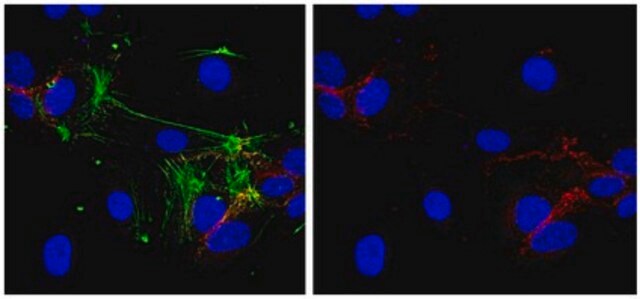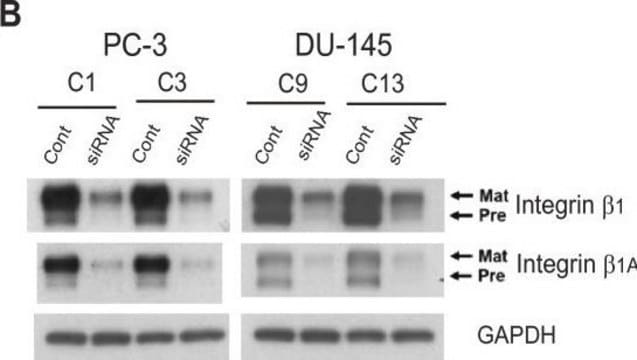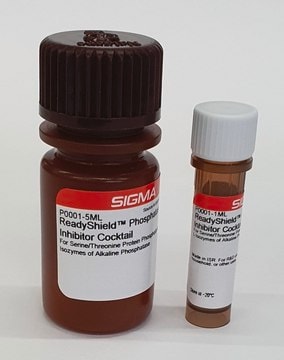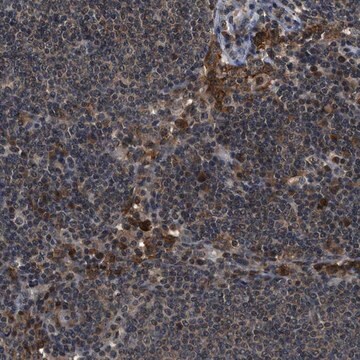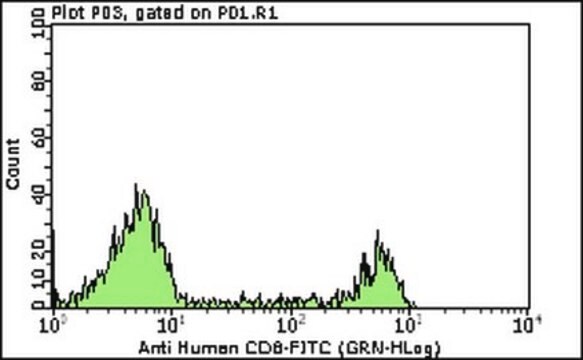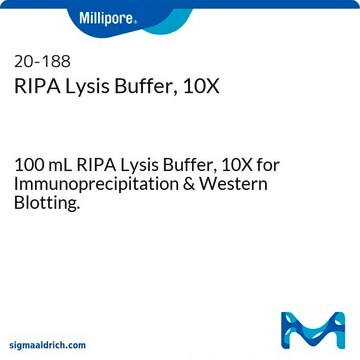추천 제품
생물학적 소스
rabbit
Quality Level
항체 형태
affinity purified immunoglobulin
항체 생산 유형
primary antibodies
클론
polyclonal
정제법
affinity chromatography
종 반응성
human
제조업체/상표
Chemicon®
기술
ELISA: suitable
western blot: suitable
NCBI 수납 번호
UniProt 수납 번호
배송 상태
dry ice
타겟 번역 후 변형
unmodified
유전자 정보
human ... MIP(4284)
특이성
Water is a critical component of all living cells. Interestingly, tissue membranes show a great degree of water permeability. Mammalian red cells, renal proximal tubules, and descending thin limb of Henle are extraordinarily permeable to water. Water crosses hydrophobic plasma membranes either by simple diffusion or through a facilitative transport mechanism mediated by special protein "aquaporin". Over the last decade, genes for several members of aquaporin family have been cloned, expressed, and their distribution studied in many tissues. Aquaporin-0 or MIP26 (major intrinsic protein 26 kDa), and Aquaporin-1 (purified from red cells) also called CHIP-28 (channel forming integral protein, 28 kDa; 268 AA; gene locus 7p14) has been the foundation of the growing family of aquaporins. The lens specific Aquaporin-0 represents up to 80% of total lens membrane protein. Defects in MIP26 are a cause of autosomal dominant cataract. The cataract Fraser mutation (CAT-FR or Shriveled) is a transposon-induced splicing error that substitutes a long terminal repeat sequence for the c-terminus of MIP. The lens opacity mutation (LOP) is an AA substitution that inhibits targeting of MIP to the cell membrane. Human Aquaporin-0 is a 263 amino acid transmembrane protein belonging to the MIP family. Aquaporin families of proteins are predicted to contain six transmembrane domains. The N and C-terminus are predicted to be cytoplasmic.
면역원
A 17 AA synthetic peptide within the carboxy terminal domain of human Aquaporin-0 (Shiels et al. 1988; Kent et al. 1990; Pisano et al. 1991; Shiels et al. 1996) was selected for antibody production. This domain is predicted to be cytoplasmic.
애플리케이션
Detect Aquaporin 0 using this Anti-Aquaporin 0 Antibody validated for use in ELISA & WB.
We recommend the use of 0.5-1% milk in all primary/secondary dilutions in order to suppress non-specific bands.
Western blot: 1-10 μg/mL using Chemiluminescence technique
ELISA: 0.5-1.0 μg/mL
Optimal working dilutions must be determined by end user.
Western blot: 1-10 μg/mL using Chemiluminescence technique
ELISA: 0.5-1.0 μg/mL
Optimal working dilutions must be determined by end user.
기타 정보
Concentration: Please refer to the Certificate of Analysis for the lot-specific concentration.
법적 정보
CHEMICON is a registered trademark of Merck KGaA, Darmstadt, Germany
적합한 제품을 찾을 수 없으신가요?
당사의 제품 선택기 도구.을(를) 시도해 보세요.
Storage Class Code
12 - Non Combustible Liquids
WGK
WGK 2
Flash Point (°F)
Not applicable
Flash Point (°C)
Not applicable
시험 성적서(COA)
제품의 로트/배치 번호를 입력하여 시험 성적서(COA)을 검색하십시오. 로트 및 배치 번호는 제품 라벨에 있는 ‘로트’ 또는 ‘배치’라는 용어 뒤에서 찾을 수 있습니다.
Xcat, a novel mouse model for Nance-Horan syndrome inhibits expression of the cytoplasmic-targeted Nhs1 isoform.
Huang, KM; Wu, J; Duncan, MK; Moy, C; Dutra, A; Favor, J; Da, T; Stambolian, D
Human Molecular Genetics null
M M Pisano et al.
Genomics, 11(4), 981-990 (1991-12-01)
Major intrinsic protein (MIP, also called MP26) is the predominant fiber cell membrane protein of the ocular lens. MIP has been suggested to play a role in cell-cell communication in the lens. Its expression is tissue-specific and developmentally regulated. We
Yuefang Zhou et al.
Differentiation; research in biological diversity, 102, 1-9 (2018-05-26)
Ephrin type-A receptor 2 (EPHA2) and one of its ligands, ephrin-A5 (EFNA5), have been associated with loss of eye lens transparency, or cataract, - an important cause of visual impairment. Here we show that mice functionally lacking EPHA2 (Epha2-null), EFNA5
Homology of MIP26 to Nod26.
A Shiels et al.
Nucleic acids research, 16(19), 9348-9348 (1988-10-11)
Rachel K Tittle et al.
Developmental biology, 350(1), 50-63 (2010-12-04)
DNA methylation is one of the key mechanisms underlying the epigenetic regulation of gene expression. During DNA replication, the methylation pattern of the parent strand is maintained on the replicated strand through the action of Dnmt1 (DNA Methyltransferase 1). In
자사의 과학자팀은 생명 과학, 재료 과학, 화학 합성, 크로마토그래피, 분석 및 기타 많은 영역을 포함한 모든 과학 분야에 경험이 있습니다..
고객지원팀으로 연락바랍니다.
